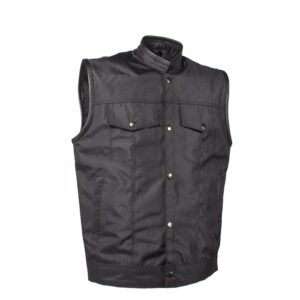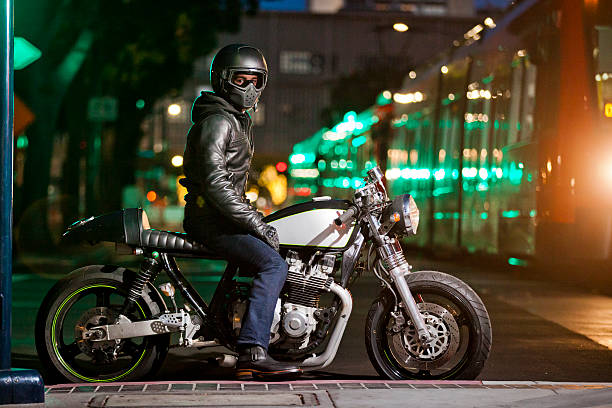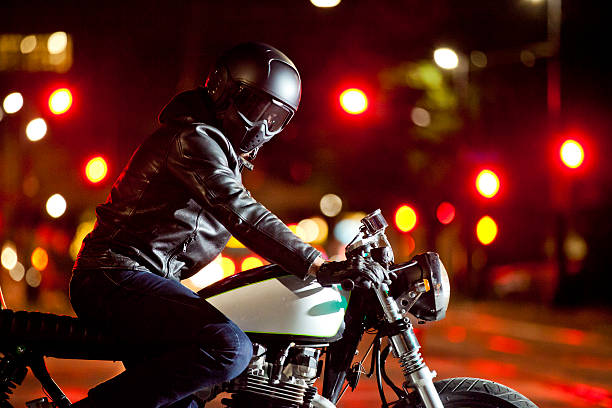Rise of Lightweight Vests: Materials and Technology
Innovation in outdoor gear and fashion has focused on functionality and style in vests. As a result of textile and material science advances, the lightweight leather motorcycle vest stands out among the many possibilities. This vest protects motorcyclists and follows the trend of lightweight vests for outdoor excursions and urban commutes.

Vest technology began with a simple goal: comfort, protection, and function without weight. Traditional vests, constructed of wool or thick cotton, were warm and durable but not comfortable or versatile—the development of synthetic fibers allowed for lighter, stronger, and more environmentally adaptable garments.
Polyester and nylon are common materials for lightweight vests. Known for their durability and ease of maintenance, these fabrics have been created to promote water resistance, windproofing, and breathability. These synthetic fibers can give UV protection and moisture-wicking qualities, improving outdoor wear.
Technology is crucial to vest design. Manufacturers may now make vests with less waste and more comfort using 3D knitting and seamless assembly. These procedures allow clothes to fit the body better, minimizing bulk and improving mobility. Stretchable textiles in vital areas improve fit and range of motion, which is essential for flexible activities like climbing and cycling.
Insulation technologies that challenge down feather stuffing are another significant advancement. PrimaLoft and Thinsulate are equivalent warmth-to-weight synthetic insulations that work better in damp situations. Even damp, these materials insulate, giving reliable warmth in many weather conditions. They are also more ethical and sustainable, appealing to a rising segment of animal welfare and environmentalist consumers.
Sustainable lightweight vest production is a priority. Recycled materials and eco-friendly techniques are growing in the sector. Vests constructed from recycled polyester from post-consumer plastic bottles are eco-friendly and high-performing. These efforts are part of a circular fashion movement to reduce waste and reuse resources.
Lightweight vest innovation goes beyond outdoor and sporting wear. The fashion industry has adopted these innovations, incorporating high-tech materials and construction methods into ordinary clothes. Designers are mixing design and function to produce adaptable and attractive lightweight vests. The result is a variety of styles for different events and interests, from sleek, urban-inspired to rugged, adventure-ready.
Technology and materials have evolved lightweight vests, reflecting a more significant trend in apparel and gear: maximum performance and environmental responsibility. Products that match these requirements will become more popular as consumers become more educated and discerning. Innovation and sustainability are changing vests and how we dress for the outdoors and the city.
Lightweight vests have grown due to technological and material science advances that have changed the garment business. From the motorcycle vest that blends style and safety to the lightweight outdoor gear that provides warmth, these clothes are revolutionizing apparel design. Innovation, sustainability, and performance will lead to more intriguing lightweight vest improvements in the future.

Light Traveling: Long Ride Vest Selection
The open road’s thrill and the environment’s beauty make a lengthy motorbike ride thrilling. Skill, endurance, and the correct gear for comfort and safety are needed for this expedition. The lightweight leather motorcycle vest is a rider requirement. Riders need this simple gear for safety, functionality, and elegance.
Material, design, storage capacity, and safety elements must be considered while choosing a long-ride vest. Motorcyclists prefer leather for its durability and style. Lightweight leather vests are ideal for weather protection and mobility. However, textile innovations like vented mesh, Cordura, and Kevlar-reinforced fabrics improve breathability and abrasion resistance for lengthy rides in different climates.
Vest design is about utility and comfort, not simply beauty. A good vest should fit snugly to reduce flapping at high speeds and be pleasant to wear for long durations. Adjustable side locks or stretch panels allow different layers underneath as weather changes. Mandarin collars provide neck protection without the pain of flapping collars.
Storage is essential, too. Carrying maps, tools, water, and snacks is common on long journeys. A vest with many pockets can make a difference. Look for designs with inside and outside zippered, snap, or Velcro pockets. Extra pockets for valuables or hydration bladders make some vests better for long-distance travel.
Road visibility is crucial for safety. Many lightweight vests have reflective stripes or high-visibility colors to make riders stand out in all lighting. Some modern leather vests have luminous aspects without sacrificing their original style.
Motorcycle vests are distinctive in personalization. Riders prefer vests with patches, club logos, or other personalization. This modification boosts aesthetics and riding community identification and togetherness.
Vest technology has improved to include armor. For safety, vests with CE-rated back, shoulder, and chest protectors add impact protection. These vests are lightweight and flexible, ensuring safety without sacrificing comfort or mobility.
Long rides across different regions require breathability and weather adaptation. Mesh panels, zippered ventilation, and moisture-wicking lining keep riders cool. Vests with replaceable thermal liners are flexible for cooler weather.
Searching for the ultimate vest includes environmental sustainability. Manufacturers are supplying eco-friendly materials or sustainable production methods as awareness develops. They appeal to ecologically aware riders who want gear that matches their principles.

The last but most critical concerns are fit and sizing. A too-tight vest restricts movement and is uncomfortable over long distances, while a too-loose vest is noisy and distracting at high speeds. Ensure vests fit comfortably, functionally, and safely by trying them on with your clothes or jackets.
In search of the perfect lightweight vest for extended motorcycle trips, motorcyclists have several options, each with its style, practicality, and protection. Individual needs, tastes, and journey demands determine the choice. The correct vest increases the riding experience and becomes part of the rider’s road-going identity, whether leather or high-tech fabric.
Picking a vest for lengthy motorcycle rides requires balancing elegance and utility. Finding a garment that protects against the elements, provides storage, assures safety with visibility and optional armor, and expresses the rider’s personality is vital. Rider options will evolve as technology and materials improve, making the journey as comfortable and safe as possible without sacrificing the freedom and excitement of motorcycle travel.





Leave a Reply